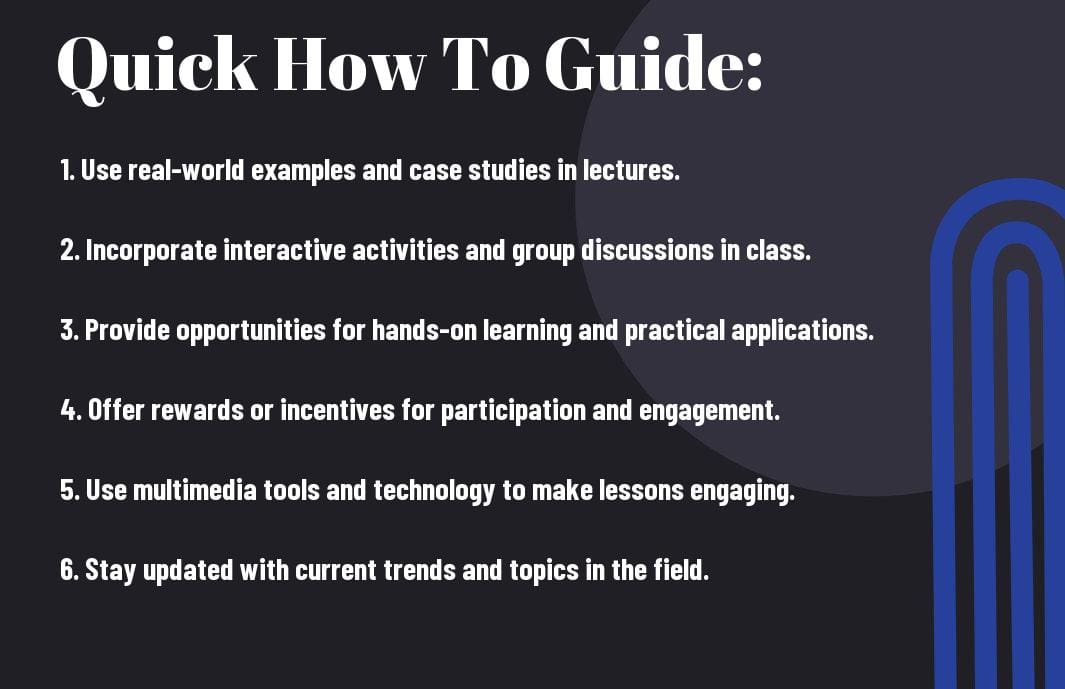Many educators struggle with students’ lack of engagement in their courses, leading to lower success rates and diminished learning outcomes. In this comprehensive guide, we will explore into proven strategies and tips to boost student engagement and keep them interested and motivated throughout the course. By implementing these effective engagement hacks, instructors can create a dynamic learning environment that inspires active participation and enhances overall student success.
Key Takeaways:
- Build a Strong Community: Creating a sense of belonging and connection among students can increase their engagement and motivation.
- Utilize Interactive Activities: Incorporating interactive elements like polls, quizzes, and group discussions can make the learning experience more enjoyable and engaging.
- Provide Timely Feedback: Giving timely and constructive feedback on student assignments and participation can help them stay on track and feel motivated to continue participating in the course.

Understanding Factors that Influence Engagement
Any effective educator knows that factors influencing student engagement are complex and multifaceted. By delving into the various elements that shape how students engage with course material, instructors can tailor their approach to better captivate their audience. Recognizing the key influences can lead to more impactful teaching strategies.
Psychological Factors
Engagement is heavily influenced by psychological factors such as motivation, interest, and perception. Students who are intrinsically motivated are more likely to engage deeply with the content, while those who lack interest may struggle to stay focused. Understanding how each student’s unique mindset affects their engagement can help educators implement interventions that cater to individual needs. Though challenging, tapping into these psychological factors is crucial for fostering a vibrant learning environment.
- Motivation
- Interest
- Perception
The ability to effectively tap into these factors can significantly impact student engagement levels and overall course performance.
Environmental Factors
Some environmental factors that can influence engagement include classroom design, technological resources, and even social dynamics. The physical environment plays a significant role in shaping the learning experience, with factors such as lighting, seating arrangements, and noise levels impacting student focus and participation. The availability of resources like interactive tools and multimedia content can also enhance engagement by providing diverse learning opportunities. The environmental factors can either hinder or facilitate student engagement, making it crucial for educators to create an environment conducive to learning.
- Classroom design
- Technological resources
- Social dynamics
The strategic manipulation of these factors can create a more engaging and dynamic learning environment that stimulates student interest and participation.
How-to Engage Students in Course Material
Tips for Interactive Teaching
After creating an engaging course material, the next challenge is to ensure that students remain interested and involved throughout the learning process. One effective way to promote interactive teaching is by incorporating group activities and discussions into the classroom. Encourage students to actively participate in debates, group projects, and presentations to deepen their understanding of the material.
- Vary teaching methods: Use a mix of lectures, group discussions, and hands-on activities to keep students engaged.
- Encourage collaboration: Foster a sense of teamwork by assigning group projects that require students to work together.
- Provide real-world applications: Connect course material to practical examples to show students how the information can be applied in the real world.
Recognizing and addressing different learning styles can also help keep students engaged in the course material.
Leveraging Technology to Enhance Learning
To enhance learning outcomes and keep students engaged, instructors can leverage technology in various ways. Little investments in technology tools such as online simulations, interactive learning modules, and virtual reality experiences can significantly enhance students’ understanding and retention of the material. A dynamic and interactive learning environment can boost student engagement and motivation.
Creating an Engaging Course Structure
Designing a Dynamic Curriculum
All great courses start with a well-designed and dynamic curriculum. An engaging curriculum should be structured in a way that captures students’ interests and keeps them motivated throughout the learning process. By incorporating a variety of teaching methods, such as lectures, group discussions, multimedia presentations, and hands-on activities, you can cater to different learning styles and engage students on multiple levels.
Incorporating Student Feedback for Improvement
Creating an opportunity for students to provide feedback is crucial for continuously improving the course structure. A simple survey at the end of each module or session can provide valuable insights into what is working well and what needs improvement. Actively listening to student feedback and making adjustments based on their suggestions not only shows that you value their opinions but also helps in creating a more engaging learning environment.

Motivational Techniques for Sustained Engagement
How-To Incorporate Gamification
Sustained student engagement can be achieved through the implementation of gamification techniques. By incorporating elements of game-playing such as points, levels, and rewards, educators can create a more interactive and enjoyable learning experience. Gamification not only motivates students to actively participate but also fosters a sense of competition and achievement, keeping them interested and invested in the course content.
Recognizing and Rewarding Participation
Now, one of the most effective ways to maintain student engagement is by recognizing and rewarding their participation. By acknowledging and celebrating students who actively contribute in discussions, complete assignments on time, or achieve milestones, educators can create a positive reinforcement loop. This not only encourages continuous engagement but also boosts morale and motivation among students.
To summarize, implementing gamification techniques and recognizing student participation are crucial in sustaining engagement in an online course. By incorporating elements of games and providing positive reinforcement, educators can create a dynamic and stimulating learning environment that keeps students interested and motivated throughout the duration of the course.
Final Words
To wrap up, keeping students engaged in a course requires a proactive approach that incorporates various hacks and strategies. By applying the tips mentioned in this guide, educators can create a dynamic learning environment that captivates students’ attention and fosters a passion for learning. Keep in mind, the key lies in maintaining a balance between interactive activities, varied teaching methods, and providing valuable feedback. With these tools in hand, educators can successfully keep students interested and actively participating in their courses.
FAQ
Q: Why is student engagement important in a course?
A: Student engagement is important in a course because it enhances learning outcomes, increases retention rates, and fosters a positive learning environment. When students are actively involved in the learning process, they are more likely to understand and retain information better.
Q: What are some effective hacks to keep students interested in a course?
A: Some effective hacks to keep students interested in a course include using multimedia elements such as videos and interactive presentations, incorporating real-world examples and case studies, providing hands-on activities and group projects, offering incentives like rewards or certificates, and encouraging active participation through discussions and Q&A sessions.
Q: How can instructors measure student engagement in their course?
A: Instructors can measure student engagement in their course through various methods such as tracking attendance and participation, analyzing quiz and assignment performance, conducting surveys to gather feedback, monitoring online interactions and discussions, and observing student behavior and interest levels during lectures or activities.




